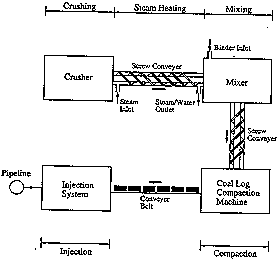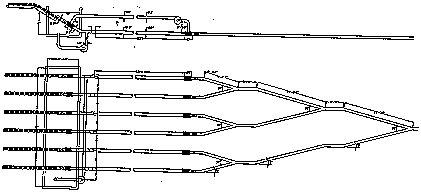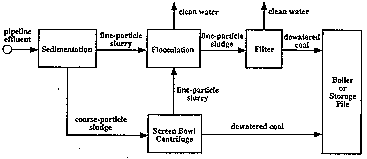Warning: The text reproduced here is a copy of information published elsewhere. This information has either:
- been published freely on the internet and has been cached here as a precaution against future loss of servers and links, or
- been published historically and very few copies of the original text are still available for research purposes.
It is recommended that you look at the original source given below first, and use this text only if that source is not available to you. It is not intended that any text cached here infringe the copyright of the original author. If any copyright owner wishes their text removed from this site, this can be done by contacting the author.
Document summary:
- Title: Coal Log Pipeline System Description
- Author: Thomas Marrero
- Source: http://www.missouri.edu/~cprc/
- Copyright: Thomas Marrero/University of Missouri-Columbia
- Date: 1996
Coal Log Pipeline System Description
Basic Concept
Coal log pipeline (CLP) is a new technology for transporting coal in which coal at the mine site is treated and compacted into cylindrical shapes (coal logs). Then the coal logs are injected into an underground pipeline filled with water for transportation to destination which may be one or more than one power plants, or to a train station, a barge terminal, or a seaport, for intermodal transportation.
Optimum operation of CLP requires that the coal logs be compacted to a diameter ratio (i.e., log diameter divided by pipe inner diameter) between 0.9 and 0.95, and an aspect ratio (i.e., log length divided by log diameter) between 1.6 and 2.0. The compacted coal logs have a specific gravity in the range 1.25.- 1.35. To minimize coal log wear in pipeline and minimize the energy required for pumping, the water in the pipe must move at a mean velocity of 0.85 VL (approx.), where VL is the lift-off velocity calculated from [12]:
In the above equation, S is the specific gravity of the coal logs; g is the gravitational acceleration; a is the aspect ratio; k is the diameter ratio; and D is the inner diameter of the pipe.
Coal Log Pipeline System
A coal log pipeline (CLP) system consists of four major subsystems: inlet, outlet, booster pump and pipeline.
Inlet
The inlet subsystem can be further divided into three main parts: coal preparation (including crushing, conveying, steam heating and mixing with binder), compaction of coal logs, and injection of coal logs into pipeline (see figure below).

Because the economic analysis is to compare coal transportation cost by CLP with other modes such as railroad, the CLP inlet system considered starts coal preparation with crushing coal from the size normally carried by trains or trucks (2 inches top size). The crusher reduces the coal to a size suitable for making coal logs (1/4 inch top size). For best result, crushing should reduce the coal to a top size about 1/20 of the coal log diameter, and a particle size distribution near that of maximum packing density. Heating of the crushed coal can best be done by steam heating while the coal is being moved by screw conveyors. Heater is not needed unless heating is required for a given coal log compaction process. When binder is needed for any coal log compaction process, it will be added to the coal in a mixer. The mixer is not needed unless binder is used. The most practical binder at present (1995) is Orimulsion which is a low- cost emulsified asphalt imported from Venezuela. Coal log compaction is to be done with a specially designed machine system.
Injection of Coal Logs into Pipeline:
Coal log injection into pipeline is accomplished by the system shown in Fig. 4.2 (below). The injection system operates in a manner described in [14].

Outlet
The outlet subsystem of CLP is illustrated in clickable image on right. It consists of a reservoir to collect the water effluent from the pipe, a conveyor belt to transport the coal logs out of water and to a stock pile, and crushing of the logs by a crusher. Depending on individual preferences, coal logs may or may not be crushed prior to stockpiling.
The coal particles in the effluent water are removed (dewatered) through a process illustrated in clickable image on left. The dewatering process includes two stages: the larger particles settle in the sedimation tank, and the finer particles settle in the flocculation tank. The coal particles are then removed from the bottom of the two tanks as sludge. The sludge from the sedimentation tank consists of coarse coal particles; it is pumped into a screen-bowl centrifuge for dewatering. The dewatered coal fines, containing less than 30% water is burned with the coal log fuel. The coal sludge from the flocculation tank consists of fine particles; it must be dewatered by filtration rather than centrifuging. The effluent water from the centrifuge is sent back to the flocculation tank for further cleaning. The clean water from the flocculation tank is reused at the power plant for steam cooling and/or other purposes.


Booster Pump
For long coal log pipelines, booster pumps are needed at intermediate stages so that the maximum pressure in the pipe and the pump can be limited to 1,500 psig approximately. The most suitable booster pump for CLP is the pump bypass . As shown in clickable image on right, the pump bypass consists of a set of pipes, a pump and eight valves. The valves must be opened and closed alternately, four at a time, to make the coal logs to bypass the pump. With this system only water passes through the pump; the logs bypass the pump. Consequently, ordinary slurry pumps or sludge pumps can be used for CLP.
Automatic computer control of the CLP system is a must.

Coal Log Compaction Processes
Researchers at Capsule Pipeline Research Center (CPRC) have tried to make coal logs under a variety of conditions. Some required heating of the coal to temperature above 100 celcius before the coal was compacted without the use of a binder, and some required the use of 0.5 to 3% binder (Orimulsion) either without heating or with heating to temperature below 100 celcius. Many other conditions, such as compaction pressure, particle size distribution, mold type, compaction piston (rain) shape and so on, also were found to affect the coal log quality (wear resistance and water resistance).
More than forty different processes were evaluated for wear resistance [15] - determining the distances such logs can endure in a commercial CLP without losing more than 3% weight due to wear. The cost of each of these processes was determined and compared with each other [16]. Based on these studies, eight compaction processes were selected for both subbituminous and bituminous coal. They are process D-1, D-2, D-3, C-2, C-3, and so forth in left clickable image for subbituminous coals, and in left clickable image for bituminous coal. Note that the numeral following each process indicates the anticipated coal log weight loss in percent due to wear through pipeline. For example, D-3 refers to process D with 3% weight loss and so on.
The use of different processes for different distances ranges and for two different coals represents a sophistication the present economic report over the 1993 report [9]. This degree of sophistication is possible due to extensive coal log wear tests in laboratory pipes since 1993 [17]. Still, it must be realized that the distance ranges listed in the tables below were estimated from laboratory test data projected to field conditions.
| PROCESS IDENTIFICATION | D-1 | D-2 | D-3 | C-2 | C-3 | L-1 | L-2 | L-3 |
|---|---|---|---|---|---|---|---|---|
| Distance Range (miles) | 10-50 | 50-100 | 100-200 | 200-400 | 400-600 | 600-700 | 700-1200 | 1200-2000 |
| Binder (% Bitumen) | 0 | 0 | 0 | 0.5 | 0.5 | 0.5 | 0.5 | 0.5 |
| Pressure (psi) | 10,000 | 10,000 | 10,000 | 8,000 | 8,000 | 20,000 | 20,000 | 20,000 |
| Temperature (°C) | 90 | 90 | 90 | 90 | 90 | 90 | 90 | 90 |
| PROCESS IDENTIFICATION | D-1 | D-2 | D-3 | C-2 | C-3 | L-1 | L-2 | L-3 |
|---|---|---|---|---|---|---|---|---|
| Distance Range (miles) | 10-20 | 20-40 | 40-60 | 60-100 | 100-150 | 150-200 | 200-300 | 300-900 |
| Binder (% Bitumen) | 0 | 0 | 0 | 0.5 | 0.5 | 0.5 | 0.5 | 0.5 |
| Pressure (psi) | 10,000 | 10,000 | 10,000 | 8,000 | 8,000 | 20,000 | 20,000 | 20,000 |
| Temperature (°C) | 90 | 90 | 90 | 90 | 90 | 90 | 90 | 90 |
Since no coal logs have so far been tested under conditions similar to those encountered by future commercial coal log pipelines, the projections (estimates) used must be considered as rough estimates. They must be checked with future tests data in large (at least 6-inch diameter) pipelines constructed in the same manner future CLP will be constructed, including smooth joints, good pipe alignment, mild and precise bendings, etc. Since such a pipeline will be constructed and used for testing coal logs in a pending proposal [18], more definite results on the endurance of coal logs (made of various processes) in commercial CLP will be available in the next two years. They will be used in the next revision of the economic report in 1997.
References
Unfortunately these were ommitted from the original text.